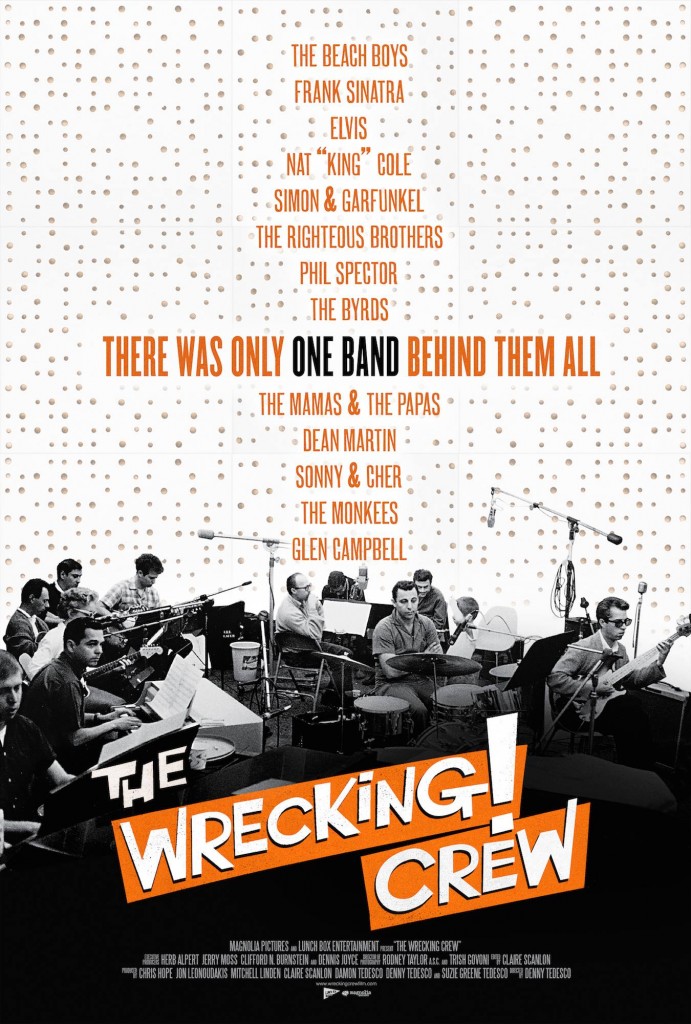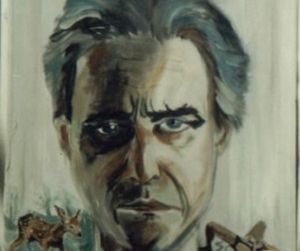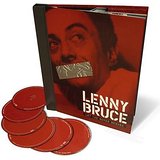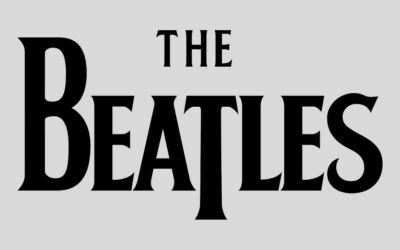By Harvey Kubernik c 2015
The movie tells the story of the unsung musicians that provided the backbeat, the bottom and the swinging melody that drove many of the number one hits of the 1960s.
one hits of the 1960s.
This film also chronicles the1950-1983 world of Gold Star studio and the session players. The film is a fun and moving tribute from Denny to his father and to the music, the times and to the secret star-making machine known only as “The Wrecking Crew”.
Tedesco and his dedicated crew interviewed: Al Casey, Al Jardine, Bill Pitman, Bones Howe, Brian Wilson, Carmie Tedesco, Carol Kaye, Cher, Chuck Berghofer, Dave Gold, Dick Clark, Don Randi, Earl Palmer, Gary Lewis, Glen Campbell, Hal Blaine, Herb Alpert, Jimmy Webb, Joe Osborn, Julius Wechter, Larry Levine, Leon Russell, Lou Adler, Lew McCreary, Mickey Dolenz, Nancy Sinatra, Peter Tork, Plas Johnson, Roger McGuinn, Snuff Garrett, Stan Ross, and Tommy Tedesco.
Filmmaker Denny started the film in 1995 when his father Tommy was diagnosed with terminal cancer.
I’ve been continually writing about the Wrecking Crew and the Gold Star principals for over 40 years in articles long before it was fashionable. To be specific, when they first were booked in the studios around Southern California they really weren’t collectively known by that name at the time, either. It was always Musicians Local 47 member.
“After being a member of both Kaleidoscope and the Nitty Gritty Dirt Band, I began working as a sideman for Linda Ronstadt, John Stewart and Hoyt Axton,” recollected instrumentalist/songwriter Chris Darrow.
“During this period I ended up doing a lot studio work in Hollywood and Los Angeles with Stewart and Axton as well as James Taylor, John Fahey and many others. As a member of the American Federation of Musicians, Local 47, I would have to call and see if the money from the sessions had come in. If so, I would drive to the office on Vine Street with copies of my W-2 forms and pick up the checks. Since I lived an hour away in Claremont, rush hour became an issue for me.
“One day I went to the Union and the check line was pretty short, so I was all ready to go visit a friend of mine until the traffic cleared. I was third in line and noticed that the person in front of me was the great drummer, Hal Blaine. The first guy in line picked up his check and was out in a flash. When it was Blaine’s turn, he pulled out a big stack of W-2s and laid them out on the counter. It took over 20 minutes for him to go through all the checks he was going to get that day. That’s how popular he was! I picked up my two checks and was out of there in no time.”
My own 2014 book, Turn Up The Radio! Rock, Pop, and Roll In Los Angeles 1956-1972 devotes entire chapters to the men and women involved in those landmark sonic creations.
In addition, I recorded with the Wrecking Crew a handful of times during 1978. On one session I provided percussion and banged tambourine along with Rodney Bingenheimer on what many consider the last time Phil Spector assembled the Wrecking Crew.
It was for a Paley Brothers’ recording track for “Baby, Let’s Stick Together,” cut at Gold Star recording studios in East Hollywood. Larry Levine engineered.
I was also the anointed food runner going to Canter’s Delicatessen for the hungry throng.
In 2015, Andy Paley emailed me his recollection of that memorable evening.
“On the recording are Julius Wechter (vibraphone), Steve Douglas (sax), Jim Keltner (drums), Tommy Tedesco (guitar), Barry Goldberg (grand piano), Don Randi (baby grand piano), Dwight Twilley (percussion), Jay Migliori (sax), Richard Hyde (trombone), Jonathan Paley (acoustic guitar) , Andy Paley (upright ‘tack’ piano) , Hal Blaine (drums) , Ray Pohlman (bass) you and Rodney (percussion), Dan and David Kessel (acoustic guitars with my brother Jonathan) and Phil Spector (percussion).
“The song was an up-tempo version of ‘Baby, Let’s Stick Together.’ I sang lead ….my brother Jonathan sang harmony. We got our vocals done very quick. Just a couple of takes. Phil really dug it.
“Phil kept Steve Douglas and Jay Migliori for another hour or so for some overdubs.
“Joey Ramone stopped by the session to say hi. He flipped! He called Seymour Stein in New York ….held the phone up to the speakers in the control room the studio ….he was raving!
“About a month later the Ramones went into the studio with Phil. Darlene Love also showed up to say hi. It was the LAST session at Gold Star with all of those guys. He did other sessions with them after that but NOT at Gold Star.”
Bingenheimer and I also hand clapped with several of the same members during tracking dates on the Spector-produced End of The Century Ramones’ album. In 2002 I penned the liner notes to a CD of End of The Century.
“I grew up going to Gold Star and Wrecking Crew recording sessions with my dad, Barney Kessel (guitar) and my stepmother B.J. Baker (Vocal contractor/background singer), who were both on all kinds of records with the Wrecking Crew,” offered David Kessel.
“I was impressed as a kid how these guys could construct a record in the studio, and then I’d hear it on the radio. I had the privilege of growing up to be 2nd generation, playing on lots of records produced by Phil Spector. This includes recordings with John Lennon, Harry Nilsson, Cher, Celine Dion, Darlene Love, Leonard Cohen, Dion, and the Ramones,” Kessel continued.
“What a complete profession thrill it was to work with the best of the best of musicians. The Wrecking Crew had a mixture of Rock and Jazz musicians that could almost read each other’s minds. This included Hal Blaine, Don Randi, Terry Gibbs, Tommy Tedesco, Don Peake, Jim Keltner, Frankie Capp, and host of greats.
“The Wrecking Crew were the best of the best, if you wanted a great record. I can hear my dad and Hal Blaine all over The Beach Boys Pet Sounds and hundreds of other records.
“A lot of the sessions I attended as a kid and started playing on as a teenager we’re done at Gold Star Studios in Hollywood. One funny thing really blew my mind. If anybody got a sexually transmitted issue (the story to the wife or girlfriend), was that they would always blame it on the bathroom at Gold Star. Which wasn’t true of course,” he laughed.
“It is with much positive emotion and appreciation, that I’m happy The Wrecking Crew movie, directed by Denny Tedesco is having a theatrical release. What a rare group of recording musicians.”
Guitarist Don Peake studied with Barney Kessel, Howard Roberts and Joe Pass. Peake then toured with the Everly Brothers during 1961-1963, and subsequently was invited into countless Phil Spector, Brian Wilson Sonny Bono, Barry White and Freddie Perren-produced recording sessions.
In 1964 Don became the first white guitarist to play and record with Ray Charles. That stint lasted for ten years. Peake arranged “If I Were a Carpenter” for Bobby Darin and is the lead guitarist on Marvin Gaye’s “Let’s Get It On.”
Peake has arranged recording dates for Roy Orbison, Minnie Riperton, the Fifth Dimension and the Monkees.
“For the Monkees I hired Mike Deasy and Glen Campbell,” mentioned Peake. “I’m the guy who hired Glen to come in. I’m still not sure as to who played the beginning lead on ‘Mary, Mary.’ I don’t know if it was Glen or Mike Deasy. I think Jim Gordon was playing on some of those sessions.
“I had known Lester Sill, who helped put the music together for the Monkees, from years earlier, including playing on Phil Spector sessions,” he volunteered.
“I believe that’s the way it is in this industry, you know. There’s a kind of a continuum and it’s we’re all on this kind of string. And we’re the best of string that keeps the pearls that makes the necklace.
“On the Monkees’ dates I would sometime pick up a guitar and sometimes I would not. But I was always the guy standing up on the podium. I was the leader. And Mike Nesmith depended upon me to communicate in musical terms and on paper what he could not. I was thrilled to be doing it with him.
“My life as an arranger and player is easier when the tune is good,” concluded Peake. “And there were a lot of good tunes. Longevity has to do with the song. Yes, there are good performances and yes there are certain records where performance means a lot, but truly the thing that makes something memorable is the song. I had great fun on those sessions. I later played on the Jackson 5 records and then the Partridge Family.”
“We created a lot of music that became renewable copyrights just by what we played.” Mike Melvoin told journalist, Kirk Silsbee earlier this century.
“Sometimes they’d put a lead sheet in front of you that just had a few basic chords, and we brought that stuff to life and made music out of it. Many times, people booked sessions and they didn’t have the faintest idea of what they wanted. The L.A. studios had the reputation of being able to interpret and create any kind of music and sounds that you wanted.”
During 2015, I conducted an interview with Don Randi. We discussed Jack Nitzsche, Neil Young and the Wrecking Crew. Randi’s autobiography will be published in September by Hal Leonard.
“And, as great as it was, we were making up parts half the time. With Jack, Phil was able to go to Jack and he would translate what Phil wanted. There was camaraderie. You got to remember we all were together. Jack Nitzsche, Phil Spector, myself and Sonny Bono, who Jack knew from the late ‘50s at Specialty Records.
“You know what kills me, every time I hear Jack’s ‘The Lonely Surfer.’ I’m on it. It still gives me chills because it’s a great song. Jack wrote a great song. I didn’t hear it until the day we went in. You know, we never rehearsed. (laughs). The composition. I’ll tell you what gripped me was his brilliance. And the smart producers realized that and they would put together some combinations that actually forced that because they wanted that edginess,” Randi emphasized.
“Jack Nitzsche called me to play keyboard on some dates in 1967 at Sunset Sound. I picked out the piano for the studio. [laughs]. A guy who had a store on Beverly Blvd. When I walked into Sunset Sound I didn’t realize it was for Buffalo Springfield. I thought it was for a Neil Young (solo) album, ‘cause that is what he was supposed to be breaking away from and going on his own. Hal Blaine and Jim Horn are on the track. I played piano and organ.
“When Jack and Neil asked me to play on the end part of ‘Broken Arrow’ they were both waiving me on to keep playing. I kept lookin’ up at them, ‘are you ever gonna tell me to stop?’
“Let me tell you something. Jack really enjoyed working with Neil. This goes as well to ‘Expecting to Fly.’ Russ Titelman, Carole Kaye and Jim Gordon are on it. I’m on piano and harpsichord.
“Jack and I never judged artists by their voices. To me it didn’t matter ‘cause I loved the music so much. And Neil was able to sell it. There are some people you can’t stand them on record until you see them live. And once you see them live you can understand their records. That doesn’t happen a lot. But it does happen.
“You gotta remember, by 1967 some of the recording studios in town, like Columbia and Sunset Sound now had 8-track tape machines. When it happened I welcomed it but all I thought of at that point, ‘well the studios are gonna get rich now.’ Because nobody is gonna know how to mix this stuff.
“And when they mix it they’re gonna have to come down to mono because nobody has got stereos to play it on. And guys like Jack and Neil with 8-track now had more options and tracks to fill. But what makes me wonder how did Brian [Wilson] do it on 4-track?”
One other thing to consider about the soon to be further recognized impact and well-deserved praised legacy of the Wrecking Crew are the nutritional aspects of the famed squad that never seem to get examined, let alone chronicled.
Many times I was invited to join several of the cats as well as producers Brian Wilson, Phil Spector, Kim Fowley, Jack Nitzsche, and Don Randi for a late night dinner nosh or requested for lunch around their activities.
In 2015, friend and surfer Peter Piper reminded me of a groovy encounter we had in 1968 with Sonny & Cher at Pop’s Hamburgers on La Brea Ave. after working at Gold Star with their managers Charlie Greene and Brian Stone.
By 1970, I’d occasionally gather in the evening with some of the session musicians, Mike Love, songwriter Stephen Kalinich, Brian Wilson. Micky Dolenz, Bobby Womack, Denny Bruce and Chris Darrow at a restaurant operated by Warren Stagg named H.E.L.P. (Health, Education, Love, Peace) on the corner of 3rd Street and Fairfax Avenue.
“Can I order a boysenberry shake and a carob cookie?”
It was only in the later part of the Sixties that professional catering and food on premises, often on record label budgets, and being delivered into the studios, became part of the scene and collaboration.
Don Randi headed the house band at Sherry’s cocktail bar on Sunset Boulevard from 1957-1970, disclosed the Wrecking Crew’s culinary habits and their favorite watering holes.
“Jack and I would go out to places like the Gaiety Delicatessen. Once in a while Harry Nilsson would come to our table. He was still working at the Crocker Citizen bank as a teller or had a job there. He might have made a record then.
“We loved Musso & Frank’s Grill on Hollywood Boulevard and Johnny’s Steak House. That was my savior. I didn’t have a fuckin dime and I could go and have a three dollar meal in there with a Rib Eye, you know. Can’t forget The Brown Derby. We went to Aldo’s, great hamburgers. Sonny and Cher dug that place, Canter’s, and once in a while, a coffee shop called Huff’s. Taco-rama, and Pink’s Hot Dogs on La Brea. Another tasty stop was The Dog House on Hollywood where you sat on stools right on the street.
“Chris Darrow reminded me of The Burrito King on Sunset Boulevard at Alvarado. The Flying Saucer. The best French Dip sandwiches in town. Near Wilshire. There was Young China, two doors down from radio station KFWB for fantastic Chinese. On Hollywood Boulevard. The best Won Ton soup. The Italian restaurant Miceli’s was on Las Palmas.
“Dennis Wilson loved Ah Fong’s restaurant. Delicious Chinese-American food. Gene Norman owned the Marquis restaurant on Sunset Strip, along with his Crescendo and Interlude clubs. I liked the Villa Capri. Mickey Cohen was there on a regular basis. I saw him at Sherry’s as well. There was Hal’s Nest, and The Speak, where all drinks were 39 cents. Phil and I went to The Cock’n Bull. The trout was incredible.
“The record company promo men all went to an Italian spot named Martoni’s. Label owners [Verve Records] like Norman Granz enjoyed the Pacific Dining Car. Barney Kessel and his wife B.J. Baker requested their New York steaks cooked medium at Diamond Jim’s in Hollywood.
“As you well know, we all went to the Hollywood Ranch Market. Are you kidding? The tater tots and the chicken gizzards! In the late fifties they had a donut machine there! [laughs]. I saw Lucille Ball one late night. In a full fur mink coat! She gave me the biggest smile. Rock bands, hookers, actors and hippies were at the counter. Especially when there was a show at The Kaleidoscope or Hollywood Palladium.
“Myself, Jack, Neil [Young] and Denny Bruce also liked to eat at the House of Pancakes on La Cienega. They just closed Hamburger Hamlet on Sunset Boulevard! What the fuck is going on?”
(Harvey Kubernik has been a music journalist for over 42 years and is the author of 8 books.
In 2009 Kubernik wrote the critically acclaimed Canyon of Dreams: The Magic and the Music of Laurel Canyon, published by Sterling. In summer 2012, the title was published in a paperback edition.
With his brother Kenneth, Harvey co-authored the highly regarded A Perfect Haze: The Illustrated History of the Monterey International Pop Festival, published in 2011 by Santa Monica Press.
Otherworld Cottage Industries in February 2014 published Harvey Kubernik’s book It Was Fifty Years Ago Today: The Beatles Invade America and Hollywood.
During April 2014, Harvey’s Kubernik’s Turn Up the Radio! Rock, Pop, and Roll in Los Angeles 1956–1972 was published by Santa Monica Press.
In September 2014, Palazzo Editions packaged Leonard Cohen: Everybody Knows, a coffee-table-size volume written by Kubernik, currently published in six foreign languages. BackBeat/Hal Leonard Books in the United States.
Harvey and Kenneth Kubernik wrote the text for photographer Guy Webster’s first book for Insight Editions published in November 2014. Big Shots: Rock Legends & Hollywood Icons: Through the Lens of Guy Webster. Introduction by Brian Wilson).





